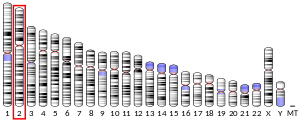
Myostatin

3HH2, 3SEK266017700ENSG00000138379ENSMUSG00000026100O14793O08689NM_005259NM_010834NP_005250NP_034964Myostatin (also known as growth differentiation factor 8, abbreviated GDF-8) is a myokine, a protein produced and released by myocytes that acts on muscle cells' autocrine function to inhibit myogenesis: muscle cell growth and differentiation. In humans it is encoded by the MSTN gene. Myostatin is a secreted growth differentiation factor that is a member of the TGF beta protein family. Myostatin (also known as growth differentiation factor 8, abbreviated GDF-8) is a myokine, a protein produced and released by myocytes that acts on muscle cells' autocrine function to inhibit myogenesis: muscle cell growth and differentiation. In humans it is encoded by the MSTN gene. Myostatin is a secreted growth differentiation factor that is a member of the TGF beta protein family. Animals either lacking myostatin or treated with substances that block the activity of myostatin have significantly more muscle mass.Furthermore, individuals who have mutations in both copies of the myostatin gene have significantly more muscle mass and are stronger than normal. There is hope that studies into myostatin may have therapeutic application in treating muscle wasting diseases such as muscular dystrophy. The gene encoding myostatin was discovered in 1997 by geneticists Se-Jin Lee and Alexandra McPherron who produced a knockout strain of mice that lack the gene, and have approximately twice as much muscle as normal mice. These mice were subsequently named 'mighty mice'. Naturally occurring deficiencies of myostatin of various sorts have been identified in some breeds of cattle, sheep, whippets, and humans. In each case the result is a dramatic increase in muscle mass. Human myostatin consists of two identical subunits, each consisting of 109 (NCBI database claims human myostatin is 375 residues long) amino acid residues . Its total molecular weight is 25.0 kDa. The protein is inactive until a protease cleaves the NH2-terminal, or 'pro-domain' portion of the molecule, resulting in the active COOH-terminal dimer. Myostatin binds to the activin type II receptor, resulting in a recruitment of either coreceptor Alk-3 or Alk-4. This coreceptor then initiates a cell signaling cascade in the muscle, which includes the activation of transcription factors in the SMAD family - SMAD2 and SMAD3. These factors then induce myostatin-specific gene regulation. When applied to myoblasts, myostatin inhibits their differentiation into mature muscle fibers. Myostatin also inhibits Akt, a kinase that is sufficient to cause muscle hypertrophy, in part through the activation of protein synthesis. However, Akt is not responsible for all of the observed muscle hyperthrophic effects which are mediated by myostatin inhibition Thus myostatin acts in two ways: by inhibiting muscle differentiation, and by inhibiting Akt-induced protein synthesis. After that discovery, several laboratories cloned and established the nucleotide sequence of a myostatin gene in two breeds of cattle, Belgian Blue and Piedmontese. They found mutations in the myostatin gene (various mutations in each breed) which in one way or another lead to absence of functional myostatin. Unlike mice with a damaged myostatin gene, in these cattle breeds the muscle cells multiply rather than enlarge. People describe these cattle breeds as 'double muscled', but the total increase in all muscles is no more than 40%. Animals lacking myostatin or animals treated with substances such as follistatin that block the binding of myostatin to its receptor have significantly larger muscles. Thus, reduction of myostatin could potentially benefit the livestock industry, with even a 20 percent reduction in myostatin levels potentially having a large effect on the development of muscles. However, the animal breeds developed as homozygous for myostatin deficiency have reproduction issues due to their unusually heavy and bulky offspring, and require special care and a more expensive diet to achieve a superior yield. This negatively affects economics of myostatin-deficient breeds to the point where they do not usually offer an obvious advantage. While hypertrophic meat (e.g. from Piedmontese beef) has a place on the specialist market due to its unusual properties, at least for purebred myostatin-deficient strains the expenses and (especially in cattle) necessity of veterinary supervision place them at a disadvantage in the bulk market.
